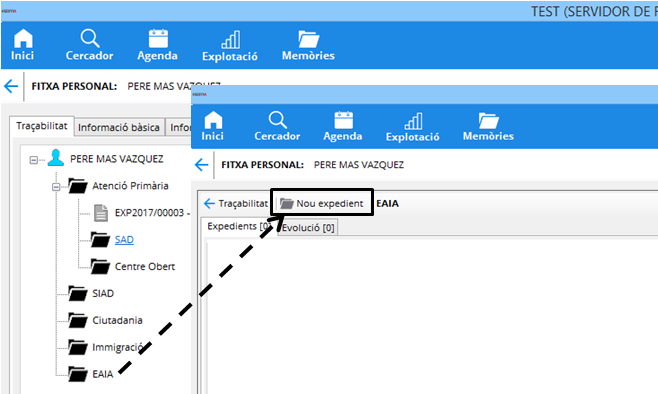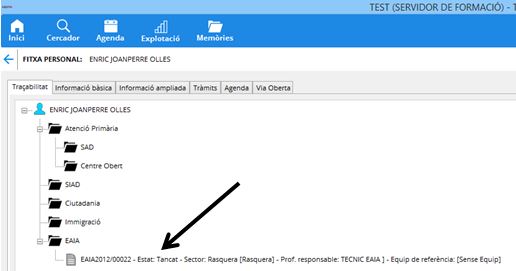In the same way as SIAD, SAD, or immigration files, EAIA files are created from the traceability tab of the Personal File, and are therefore directly linked to it.
To be able to add a new EAIA file, you must click directly on the name of this folder in the traceability tab. Hèstia will then open a window from which the new file can be created by clicking on "New file". 
Once "New file" is selected, Hèstia will open the form related to the EAIA file.
 In this form you will need to fill in a series of data that are mandatory, and that make up the cover of the EAIA file, they are:
In this form you will need to fill in a series of data that are mandatory, and that make up the cover of the EAIA file, they are:
a. Sector : Unlinkable to select the municipality to which the file belongs.
b. Subsector : Detachable to define if within the chosen sector, it belongs to another more specific territorial division (such as neighborhoods).
c. Prioritization criteria :
Urgent : Study, diagnosis and assessment of the case must be carried out within a maximum period of 72 hours. (Circular 1/2006 of March 8 of the DGAIA)
Priority : Study, diagnosis and assessment of the case must be done with a maximum period of 15 days. (Circular 1/2006 of March 8 of the DGAIA)
Preferred : A study, diagnosis and evaluation of the case must be carried out with a maximum period of 3 months. (SEAIA document May 2010)
Ordinary : Study, diagnosis and evaluation of the case must be carried out with a maximum period of 6 months.
d. Check box , Answer before 6 months: mark if when opening the File, it needs to be answered before 6 months regardless of the Prioritization Criteria.
e. Origin : Sector or municipality where the case comes from.
f. EBAS : Depending on the selection of the Sector or Municipality, this field is automatically filled in with the corresponding EBAS according to the defined configuration.
g. Report by the DGAIA/SAIA , Preparation Date and Resolution Date DGAIA/SAIA: informative data in reference to the Case Report.
h. Synthesis Title , Generation Date, DGAIA/SAIA Resolution Date and Author: informative data in reference to the Case Synthesis.
i. Educational Center : Center in which the holder of the File studies.
J. Studies : Type of studies pursued by the holder of the file.
k. Course/Year of the course : course in which it is in reference to the Studies defined in the previous point. Since this data cannot evolve according to defined criteria, it is necessary to indicate in which year the course reported here is taken, in order to have a reference that does not expire over time. For example:
Year in which it is reported Course / Year of the course 
EAIA files, unlike the rest of the Hestia modules, can be in three states. They are:
High : in this case, there is no Administrative situation defined in the File. It is used when the professional is working on a case, and which he wants to document, such as advice. When the file is in this situation, it does not appear in the monthly statistics as open, but if the advisory actions appear, as advisories.
Open : When this has an Administrative situation and this is defined in the File Evolution tab, at that moment and automatically, the file goes from being High to Open, and therefore, already participates in the statistics monthly as opening.
Closed : When the professional decides to close the file. In this state, it participates in monthly statistics such as closing.
You can easily check the status of the file in the first tab of the file, according to the color code and the text:

Once the file has been created, it can be accessed either from the traceability tab of the personal file, or from the search engine, through the EAIA file search engine.

